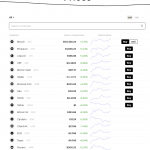The World Food Programme (WFP) is utilizing the Ethereum blockchain to distribute cash assistance to the world’s hungriest families, demonstrating that the technology can aid humanitarian organizations to safely and quickly send help to nations who need it the most.
In a WFP press release, Farman Ali, from the WFP Karachi provincial office, said:
Blockchain can revolutionize the way WFP delivers assistance to vulnerable families across the globe. It can bring us closer to the people we serve and allow us to respond much faster.
// Let us help you become financially independent. Read exclusive stories, bitcoin analysis, and tutorials. Use the coupon code “CCN5” and get $5 off. Join Hacked.com now. //
As the food-assistance branch of the United Nations and the world’s largest humanitarian organization, it is undertaking a project employing the Ethereum blockchain as it works at changing its approach to how it feeds the hungry.
Turning to the Blockchain
As well as giving food, the WFP has opened a cash assistance program called Building Blocks.
The first test was undertaken in the heart of Sindh province in Pakistan where transactions were authenticated and recorded on a public blockchain through a smartphone interface.
The WFP said:
Transaction reports generated were then used to match the disbursements with entitlements.
The WFP’s approach to adopt the Ethereum blockchain is the organization’s attempt to reduce costs and risks related to cash-based transfers.
Over the last few years, the number of cash transfers have increased for the WFP, which are proving effective and efficient at improving livelihoods in some of the poorest nations. However, by doing so poses risks.
An armored vehicle from the United Nations (UN) World Food Program (WFP) leads a convoy of UN vehicles. Credit: Flickr.
The WFP believe that with the blockchain they can explore cheaper and less risky alternatives to getting people the money they need with transparency and security in mind.
Through the use of the blockchain they can be sure that people are receiving the food and money they need. Not only that, but by knowing where the money is going, the WFP can track and verify the way families spend the funds.
The blockchain has the potential to change the way things are done for humanitarian assistance, particularly when it comes to the world’s poorest countries.
If a disaster takes place in a country where access to help is limited, organizations can use the blockchain as an efficient and quick way of distributing funds. As the technology becomes more mainstream, more organizations are realizing the benefits that it can provide, one of which is to people who live in undeveloped nations who require assistance with day-to-day living.
Featured image from Shutterstock.














